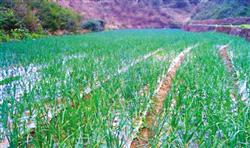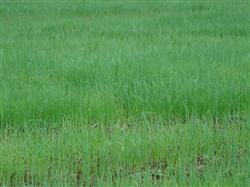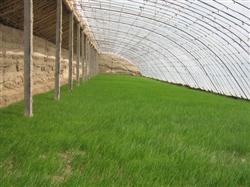Onion seedling raising should be good at "five hurdles"

Onion has the characteristics of low input, high yield, simple management and high benefit, so it is an ideal vegetable variety for vegetable farmers to commercialize production and increase income. The first ten days of September is the best time for raising onion seedlings. The main points of seedling raising techniques are introduced as follows. Purple skin varieties such as Ziyu No. 1, Ziyu No. 2, Zixing and Shuanghuanhong can be selected for seed selection. These varieties have the characteristics of strong spicy taste, high yield, good quality and suitable for export. These varieties generally have a yield of about 5000 kg per mu, and the yield of high-yield plots can reach 7500 kg per mu. The nursery bed should choose the plot with loose soil, fertile soil and strong water retention, which has not planted onions and garlic vegetables in 3 years. The nursery bed area is about 35 square meters and the seed consumption is 0.5 kg per mu of field seedlings. Apply rotten farm manure before sowing, add 20kg of nitrogen, phosphorus and potassium ternary compound fertilizer, and then ploughing and fine soil preparation to make a 1.5-meter-wide bed, watered thoroughly, waiting for sowing. The time of sowing directly affects the size of seedlings, which ultimately affects the yield of onions. Early sowing, the growth period of seedlings is prolonged, resulting in too large nutritional area, seedlings are prone to bolting; late sowing, seedlings are weak, cold tolerance is low, overwintering is prone to dead seedlings. Therefore, in order to achieve high yield, it is necessary to master the best sowing time. According to the experience of local vegetable farmers, the most suitable sowing time is 3 days before and after White Dew (early September). Using dried seeds to sow and cover fine soil after sowing, it is appropriate to see no seeds. After covering the soil, 33% of the seedbed can be sprayed with 100 ml of herbicide per mu to prevent weeds from the seedbed. After management and sowing, covering the border with a layer of wheat straw is beneficial to moisturizing, high temperature and rain protection, and the soil should always be kept moist before emergence. When about 60% of the seedlings grow on the seedling bed, the mulch can be removed and sprinkled in time according to the weather conditions to prevent the hardening of the seedbed, combined with watering and applying a small amount of urea to cultivate strong seedlings of the right age through fertilizer and water regulation. It is not only necessary to prevent the seedlings from growing too large, causing early bolting, but also to avoid the weak growth of the seedlings and affect the overwintering. Generally, onion seedlings can be planted when they grow to 4 true leaves, the plant height is 20-25 cm and the leaf sheath diameter is 6-7 mm. During colonization, onion seedlings should be transplanted separately according to the size of onion seedlings so that their growth is consistent, and large seedlings with a leaf sheath diameter of more than 8 mm and weak seedlings and diseased seedlings with a diameter of less than 3 mm should be removed. The colonization is generally completed from the end of October to the first ten days of November, and the daily average temperature is 4 ℃ ~ 5 ℃. Since it takes about 30 days from planting to resuming growth, the roots of onions must be promoted to grow well before the severe cold, so as to prevent the dead seedlings caused by freezing and lifting roots in the soil. The planting density requires a row spacing of 20 cm and a plant spacing of 15 cm, and the planting depth is better not to bury pentagonal strands. Watering after planting to promote the survival of onion seedlings, do not flood irrigation, resulting in soil consolidation, is not conducive to the rapid recovery of onion growth.
- Prev

Comprehensive control of diseases and insect pests of onion at seedling stage
First, the superior varieties can be selected in production, such as Ziyu No. 1, Ziyu No. 2, Zixing, Shuanghuanhong and so on. These varieties have the characteristics of strong spicy taste, high yield, good quality and suitable for export. These varieties generally have a yield of about 5000 kg per mu, and the yield of high-yield plots can reach 7500 kg per mu. Two.
- Next

Key techniques of Onion Seedling production
Onion is a kind of common vegetable which is resistant to transportation and storage. The planting and management of onion is easy, and the economic benefit is between 1000 and 2000 yuan per mu. The experiment shows that cultivating strong seedlings is the key measure to increase production. First, rational fertilization in terms of fertilization, it is necessary to apply sufficient base fertilizer to ensure that there is no need for topdressing in the early stage of seedlings.
Related
- Where is it suitable to grow horseradish in China? it is expected to see the middle altitude horseradish in Alishan.
- How to prevent tomato virus disease reasonably? (Control methods included)
- Many people like to plant towel gourd on the balcony. What are the main points of this method and management?
- What crops can chili peppers be mixed with?
- Fertilization techniques and matters needing attention in Tomato
- What are the grafting techniques for peach seedlings in spring?
- Harm and control methods of root swelling disease of Chinese cabbage
- What are the pests of sweet potatoes? How to prevent and cure it?
- Symptoms, causes and Control methods of navel Rot in Tomato
- The cause of "Cucumber rotten bibcock" in Farmers' planting Cucumber and its Control Plan

